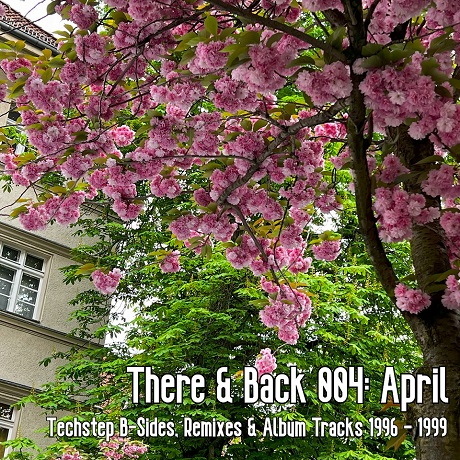
Pearsall presents There & Back 004: April, Techstep B-Sides, Remixes & Album Tracks 1996-1999
right-click, save as to download
Recorded in Berlin, June 2024
100% Vinyl
(70:49, 170.6 MB, 320 KBPS MP3)
Direct link to the mix:
https://sonicrampage.org/mixes/thereandback/Pearsall-ThereAndBack004_April_TechstepB-SidesRemixes&AlbumTracks1996-1999.mp3
Tracklisting:
- Mampi Swift – The Journey [Charge]
- Usual Suspects – Contortion [Renegade Hardware]
- Eat Static – Interceptor (Decoder Remix) [Planet Dog]
- Dom & Roland – Dumbo [Moving Shadow]
- Ed Rush & Nico – Comatone [No U-Turn]
- Future Forces Inc – Bypass [Trouble On Vinyl]
- Future Forces Inc & Nico – Chase [Saigon]
- Ed Rush & Optical – Millennium [Virus]
- Grooverider – Rainbows of Colour (Optical Remix) [Higher Ground]
- Ed Rush & Optical – Medicine (Matrix Remix) [Virus]
- Bad Company – Forgotten [Bad Company]
- Dom & Roland – Homicide [Moving Shadow]
- DJ Kane – Bruton [Riddim Track]
- DJ Krust – Resistance [V Recordings]
- DJ Krust – The Last Day [Full Cycle]
- Decoder – Tension [Elementz]
- Andy C & Shimon – Genetix [Ram]
- The Kraft – Synthetic [Frontline]
- Trace & Nico – Copies [No U-Turn]
- Doc Scott – Swarm [Metalheadz]
One of my favorite moments in electronic music history was drum n’ bass’s techstep era, and so for the fourth mix in this year’s There & Back series, I decided to return (again!) to this incredibly rich era with a special focus on lesser known tracks: b-sides, remixes, and album tracks.
Fortunately there is a lot to work with!
In fact, when I actually pulled the records off the shelves to make the mix, I realized that there was just way too much good stuff to work with, therefore this will be the first of two mixes in this theme, with a second one to follow later in the year. This one focuses on more minimal steppers and rollers, and the second one will zero in on a more aggressive, heavy-duty sound.
If that’s all gibberish to you, let’s step back and work through some definitions.
‘Techstep’ was the name given to a sub-genre of drum n’ bass that appeared in late 1995 but really hit its stride the following year, becoming a key part of the scene through the rest of the 1990’s. It represented a new strain of future-facing drum n’ bass. Out went the reggae and rare groove flavors that characterised jungle music, and in came harsh, distorted basslines over cavernous, robotic drums, all laced with distinct sci-fi sounds – snatches of dialogue from classic films like Blade Runner and Aliens, laser zaps, industrial clanks, menacing synth splashes …
What’s invigorating about darkcore is its bracing anti-musicality. With its incorporation of atonal, unpitched timbres, non-musical sounds and horror movie soundtrack dissonance, darkcore is simply far more avant garde than intelligent drum ’n’ bass. The latter, in an abiding confusion about what constitutes progression for electronic music, is too deferential to traditional ideas about melody, arrangement, ‘nice’ textures, the importance of proper songs and hands on, real-time instrumentation. Paradoxically, it’s the shit that ‘s most uncompromisingly anti-melodic, that has the highest quotient of rhythmic dissonance, which really gets the punters going.
Simon Reynolds
https://www.thewire.co.uk/in-writing/essays/the-wire-300_simon-reynolds-on-the-hardcore-continuum_4_hardstep_jump-up_techstep_1996_
When I first heard it, it blew me away. I had been a sci-fi fan since I was a child, and this was the soundtrack to the future that I’d always dreamed of.
It wasn’t in the future, it was in the now. The future had arrived.
This music still blows me away.
Maybe that’s just the nostalgia talking, but there’s a power to this sound, an energy that sounds as vital to me at 43 as it did when I was only 16.
It’s a great example of what music writer Simon Reynolds has called ‘scenius’, where a collective of people working together in a kind of friendly (and sometimes not so friendly) collaboration produce genius as a group effort. It’s the opposite to the cliche of the lone tortured rock genius, pouring his soul into song. With techstep there was a symbiosis happening between producers, dj’s, record labels, and ravers; feedback loops upon feedback loops where new music was battle tested at events like the Metalheadz Sunday Sessions at the Blue Note club in Hoxton, London, and reactions (or lack of) were relayed to the producers, who took that on board and adjusted accordingly.
I’d make tunes all week, give them to Grooverider and Fabio and I’d go down and listen to them. And I’d hear other people’s tunes and get inspiration. It was like a battle. I liked the competition. It was brilliant.
Dillinja
https://daily.redbullmusicacademy.com/2013/04/nightclubbing-metalheadz-at-blue-note
It was music that existed both for functional reasons – to make people dance when played very loud – as well as for more esoteric reasons – to explore a vision of the future as seen from the perspective of (mostly) working-class young English men. Using what would be laughably rudimentary equipment by modern standards, these producers, clustered around the Metalheadz, No U-Turn, Moving Shadow, Renegade Hardware, Ram and Emotif labels (as well as a variety of other smaller operations) took a stew of ideas and inspirations – from Belgian hardcore techno, hardcore East Coast hip-hop, ambient music, industrial sounds, weird experimental electronica, heavy-duty dub echo explorations, and much more – and merged it with decades of sci-fi signifiers to create something that was utterly cutting edge.
So many of these tricks have since become standard in modern music, even making their way into popular music’s toolbox, that it can be hard to understand just how revolutionary this music was when it first came out.
Just think about some of the innovations that came from this scene:
- Running a baseline through a guitar distortion unit to fill out the mid-range and give it an almost heavy metal intensity matched to a dub rumble – dubstep would not have been possible without this technique
- De-tuning Amen drums and using time stretching to give them a unique, robotic timbre
- Creating two sets of drum loops and switching back-and-forth through the track – later used to devastating effect in grime as ‘eight bar’
- Adding a low-pass filter to breakbeats to make drums sound like they were warping in space and time, a technique that has spread across the musical landscape ever since
- Stripping the rhythm section down to a clipped two-step beat pattern, inadvertently birthing the signature percussion of the UK Garage scene
And that’s just what I can think of off the top of my head!
Putting this mix together was a lot of fun, and I’m looking forward to making the second part soon.
Thanks for listening, and hope you enjoy the mix!
More in this vein, if you enjoyed this:
To wrap things up, here is a rare 1998 video on the Metalheadz Sunday Sessions:
